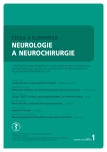SCN1A mutation positive Dravet syndrome, genetic aspects and clinical experiences
Authors:
K. Česká 1; Š. Aulická 1; P. Danhofer 1; O. Horák 1; L. Fajkusová 2; S. Pouchlá 2; H. Ošlejšková 1
Authors‘ workplace:
Klinika dětské neurologie LF MU a FN Brno, Centrum vysoce specializované péče pro farmakorezistentní epilepsie MZ ČR
1; Centrum molekulární biologie a genové léčby, Interní hemato-onkologická klinika LF MU a FN Brno
2
Published in:
Cesk Slov Neurol N 2018; 81(1): 55-59
Category:
Original Paper
doi:
https://doi.org/10.14735/amcsnn201855
Overview
Aims:
We present retrospective analysis of the set of 11 patient group with SCN1A gene (sodium voltage-gated channel alpha subunit 1) positive Dravet syndrome (DS). Patients were examined with suspected DS from 2010 to February 2017. The aim of the study was to analyse epidemiological and clinical data and to assess the efficacy of drug therapy and MRI and EEG findings.
Material and methods:
In the study the analysis of medical records of patients with SCN1A mutation positive DS and its statistic evaluation was used. We monitored development of disease, gender, types of epileptic seizures and their association with age of patient, findings on EEG and MRI, drug effect. We also evaluated the neurological and behavioral-mental status of patients.
Results:
In group of 11 patients, there were 7 women (63.6%) and 4 men (36.4%). Average age by manifestation of seizures was 6.5 months. All of the patients have mutation in SCN1A gene. The most frequent seizures were generalized tonic-clonic (81.8%). On the other hand the least occurring seizures were myoclonic seizures – only 2 from 11 (18.2%). Average time from development of symptomatology to correct diagnosis was by 116 months. In patients born before 2010 it was only 19 months.
Conclusion:
DS is from prognostic point of view serious type of epilepsy. Since 2010, 52 samples of DS suspected patients were investigated. Eleven proven causal mutations represent 21% of samples. Early diagnostics of disease and correct management is crucial for further course of disease and has major impact on mental status and predicted prognosis.
Key words:
Dravet syndrome – SCN1A gene – genetic diagnostic – manifestation – pharmacoresistency – antiepileptic drugs
The authors declare they have no potential confl icts of interest concerning drugs, products, or services used in the study
The Editorial Board declares that the manuscript met the ICMJE “uniform requirements” for biomedical papers.
Chinese summary - 摘要
SCN1A突变阳性Dravet综合征,遗传方面和临床经验目的:
我们对一组11例SCN1A基因(钠电压门控通道α亚基1)阳性Dravet综合征(DS)患者进行了回顾性分析。 怀疑DS的患者在2010年至2017年2月期间接受检查。该研究的目的是分析流行病学和临床数据,评估药物治疗疗效以及MRI与脑电图检查结果的可靠性。
材料和方法:
在该研究中,使用SCN1A突变阳性DS患者的病历分析和统计学评估。 我们监测疾病的发展,性别,癫痫发作的类型与通过EEG和MRI检查发现的患者的年龄以及药物的影响的关系。我们还评估了患者的神经行为和精神状态。
结果:
在一组11名患者中,有7名女性(63.6%)和4名男性(36.4%)。 表现为癫痫发作的平均年龄为6.5个月。 所有患者都有SCN1A基因突变。 最常见的癫痫发作可以概括为强直性阵挛(81.8%)。 另一方面,痉挛发作最少的是肌阵挛发作 - 11例中仅有2例(18.2%)发作。 从症状发展到确诊的平均时间为116个月。 2010年以前出生的患者只有19个月。
结论:
从预后的角度来看DS是一种严重的癫痫。自2010年以来,共调查了52例疑似DS患者。证实为因果突变的11位患者占样本的21%。 疾病的早期诊断和正确的管理对于疾病的进一步发展至关重要,并且可以对精神状态和预后产生重大影响。
关键词:
Dravet综合征 - SCN1A基因 - 遗传诊断 - 表现 - 药物相容性 - 抗癫痫药物
Sources
1. Danhofer P, Horák O, Fajkusová L et al. Syndrom Dravetové: těžká myoklonická epilepsie v časném dětství – kazuistiky. Cesk Slov Neurol N 2014; 77/ 110(2): 243– 246.
2. Danhofer P, Horák O, Fajkusová L et al. Syndrom Dravetové: těžká myoklonická epilepsie v časném dětství. Neurol praxi 2015; 16(1): 38– 40.
3. Aulická S, Horák O, Brunová K et al. Syndrom Dravetové v pediatrické praxi. Pediatr praxi 2017; 18(2): 100– 102.
4. Danhofer P, Brunová K, Ošlejšková H. Syndrom Dravetové (těžká infantilní myoklonická epilepsie): charakteristiky onemocnění v dospělém věku. Neurol praxi 2017; 18(2): 113– 116.
5. Brunklaus A, Ellis R, Reavey E et al. Prognostic, clinical and demographic features in SCN1A utation – positive Dravet syndrome. Brain 2012; 135(Pt 8): 2329– 2336. doi: 10.1093/ brain/ aws151.
6. Bayat A, Hjalgrim H, Moller R. The incidence of SCN1A-related Dravet syndrome in Denmark is 1:22 000: a population-based study from 2004 to 2009. Epilepsia 2015; 56(4): e36– e39. doi: 10.1111/ epi.12927.
7. Panayiotopoulos CP. A clinical guide to Epileptic syndromes and their treatment. 2nd ed. London: Springer Healthcare Ltd 2002: 283– 287.
8. Sillanpää M, Shinnar S. Long-term mortality in childhood – onset epilepsy. N Eng J Med 2010; 363(26): 2522– 2529. doi: 10.1056/ NEJMoa0911610.
9. Shmuely S, Sisodiya SM, Gunning WB et al. Mortality in Dravet syndrome: a review. Epilepsy Behav 2016; 64(Pt A): 69– 74. doi: 10.1016/ j.yebeh.2016.09.007.
10. Delogu AB, Spinelli A, Battaglia D et al. Electrical and autonomic cardiac function in patients with Dravet syndrome. Epilepsia 2011; 52 (Suppl 2): 55– 58. doi: 10.1111/ j.1528-1167.2011.03003.x.
11. Brunklaus A, Zuberi SM. Dravet syndrom – from epileptic encephalopathy to channelopathy. Epilepsia 2014; 55(7): 979– 984. doi: 10.1111/ epi.12652.
12. Meisler MH, Kearney JA. Sodium channel mutations in epilepsy and other neurological disorders. J Clin Invest 2005; 115(8): 2010– 2017. doi: 10.1172/ JCI25466.
13. Yu FH, Catterall WA. Overview of the voltage-gated channel family. Genome Biol 2003; 4(3): 207.
14. Bagnall RD, Crompton DE, Semsarian CH. Genetic basis of sudden unexpected death in epilepsy. Front J Neurol 2017; 8: 348. doi:10.3389/ fneur.2017.00348.
15. Wirrell EC. Treatment of Dravet syndrome. Can J Neurol Sci 2016; 43 (Suppl 3): 13– 18. doi: 10.1017/ cjn.2016. 249.
Labels
Paediatric neurology Neurosurgery NeurologyArticle was published in
Czech and Slovak Neurology and Neurosurgery

2018 Issue 1
- Metamizole vs. Tramadol in Postoperative Analgesia
- Memantine in Dementia Therapy – Current Findings and Possible Future Applications
- Memantine Eases Daily Life for Patients and Caregivers
- Metamizole at a Glance and in Practice – Effective Non-Opioid Analgesic for All Ages
- Advances in the Treatment of Myasthenia Gravis on the Horizon
Most read in this issue
- A neurological view on spondylodiscitis
- Parosmia and phantosmia in patients with olfactory dysfunction
- Assessment of cognitive functions using short repeatable neuropsychological batteries
- Cavernous sinus thrombosis – still occurring complication of rhinosinusitis
